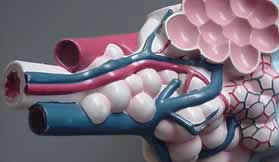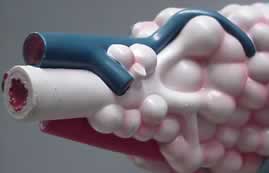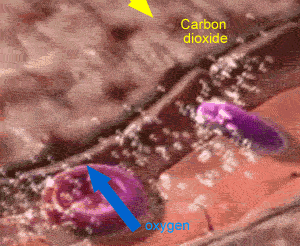
Hide internal view.

Hide internal view.
The
Lungs |
||||
| Lungs contain over 300 million tiny air sacs called alveoli that give the lungs a total surface area of 90m2. |
|
|||
Lungs are very spongy, elastic organs specializing in gas exchange. Energy is used to inflate the lungs but no energy is waisted in deflating due to the elastic nature of the lungs. The lungs deflate, much like a balloon, as shown on the right |
||||
The picture
on right is that of an alveolus. Every tube (bronchiole) in the lungs
ends up in an alveolus. An alveolus is made from many spherical structures,
resembling a bunch of grapes. This structure significantly increases
the surface area exposed to the air. The alveoli must remain moist with water as gases, such oxygen and carbon dioxide, can only move across membranes when dissolved in water. This possess a huge problem for animals with lungs. Water has a very high surface tension, that is, the water molecules are very strongly held together at the surface of the air-liquid boundary. With such a high surface area, as found in the lungs, the process of infalting the lungs would require a great deal of energy. The organism would quickly become exhausted from simply breathing. The problem is solved by lipoproteins called pulmonary surfactants which act similar to detergents to reduce the surface tension of water. Pulmonary surfactants are formed by a special type of cell found in the alveolus. The proteins and lipids that comprise the surfactant have both a hydrophilic region and a hydrophobic region. By adsorbing to the air-water interface of alveoli with the hydrophilic head groups in the water and the hydrophobic tails facing towards the air, surface tension is reduced. Pulmonary surfactants have two major functions: |

|
|||
| The image on the right shows a dissection of a sheep's lung. You can see the action of the surfactant as tiny bubbles form due to the lowering of the water tension within the lungs. |  |
|||
Scan the image above, of the alveolus, for more information. It is surprising that the blue blood vessels are labeled as arteries. Oxygenated blood usually travels through arteries away from the heart. |
||||
|
|
|||
|
Alveoli are surrounded by blood vessels that bring blood to the lungs for gas exchange. | |||
|
The alveolus increases the surface area available for gas exchange. The walls of the alveolus are thin and allow oxygen to move freely, diffuse, from the air into the blood and carbon dioxide to diffuse from the blood into the air space of the alveoli . |
|||

|
When blood reaches the body carbon dioxide and oxygen are exchanged through the thin walls of the capillaries. Carbon dioxide moves into the blood while oxygen moves out into the tissues.
|
|||
Although the lungs specialise in gas exchange it is the red blood cells that provide the gas transport to and from the lungs. Most of the CO2 entering or leaving the blood goes through red blood cells for two reasons. -Secondly O2 binds to Haemoglobin inside red blood cell at the lungs. This binding of oxygen to haemoglobin causes hydrogen ions (H+) to be released. The increase in H+ ions in the lungs causes the reaction CO2 + OH - => HCO3- . to go in reverse producing CO2 and OH -. Thus, CO2 can leave the blood across the respiratory surface.
|
||||
Blood arriving in the capillaries of the alveoli has than the alveolar air. Blood arriving in the capillaries of the alveoli has than the alveolar air. Blood arriving in the tissues of the body has than that found in the tissues. Blood arriving in the tissues of the body has than that found in the tissues. The function of the alveoli is to What is the role of surfactants in the alveoli? What role do red blood cells play in the mammalian respiratory system ? |
||||